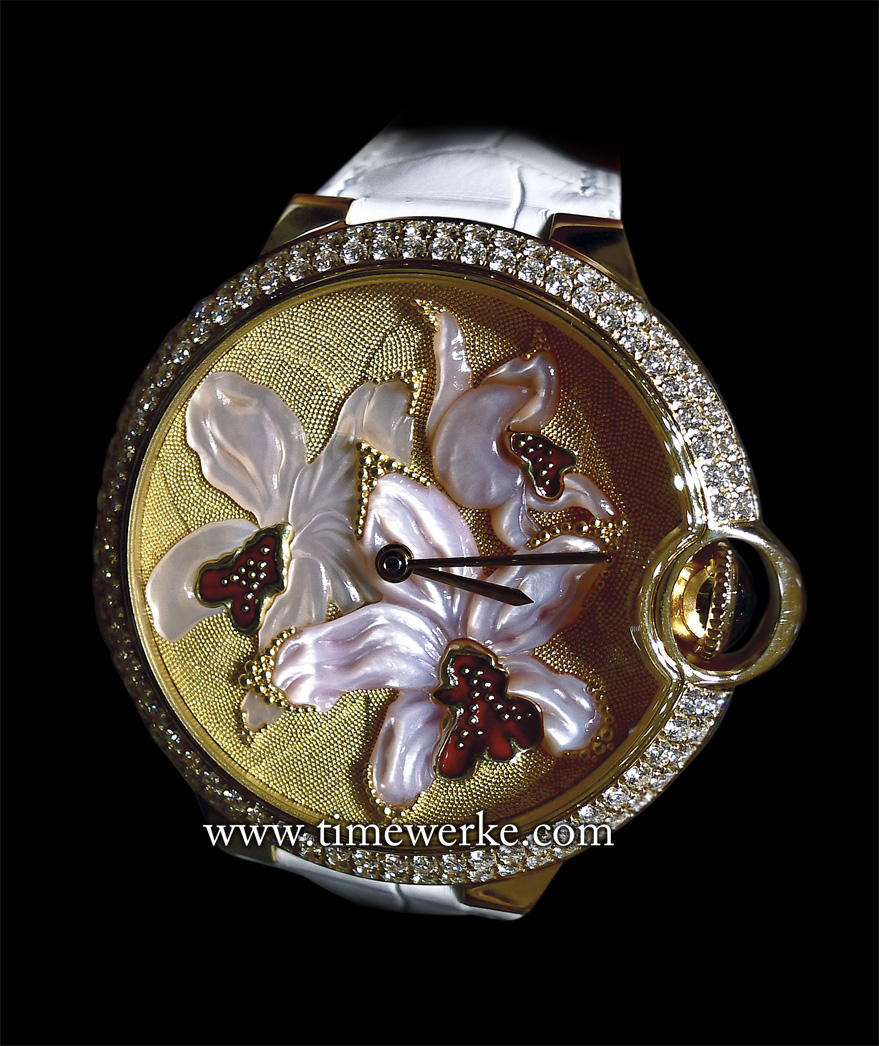
Orchid Granulation and engraved mother-of-pearl motif Ballon Bleu de Cartier 42mm watch. Introduced in 2015, this orchid granulation watch has an automatic movement and 22K yellow gold granulation on its 18K yellow gold dial. The orchid motif is in engraved mother-of-pearl and has 18K yellow gold flower petals covered in red enamel. Limited to 40 pieces. Photo: © TANG Portfolio. Elfa / Timmy. 2015 Salon International de la Haute Horlogerie.
How many orchid species are there in the world? Well, according to a report on livescience.com, orchid expert Tom Mirenda was quoted as saying that the Orchidaceae family has more than 25,000 flower species and more are being discovered every day.
Such numbers of orchid species are five times that of the mammal species, as we came to realize from the article, Seven Little Known Orchid Facts, written by Melanie Dearringer. [Source: Orchid Plant Care Info.]
While there are more orchid species thriving in tropical areas of the world, it doesn’t necessarily mean that orchids are tropical plants. Orchids can be found on every continent, except Antarctica.
Did you also know that the primary source for vanilla flavouring comes from a species of vanilla orchid known as the Vanilla planifolia that is native to Mexico?
The ripe fruit or plant pod is harvested to obtain a very popular flavour in the world – vanilla. It was first used by the Aztecs in Mexico to flavour their royal drink – the xocolati and it was a mixture of cocoa (chocolate) beans, vanilla and honey, states the National Tropical Botanical Garden.
Madagascar and Reunion are important vanilla flavouring exporters and Indonesia has been a successful producer.
According to information provided by the Kew Royal Botanic Gardens. It is also stated that 95% of the world’s traded vanilla pods are derived from this one species – the Vanilla planifolia.
While we know that the plant depicted on Cartier’s Orchid Granulation watch featuring the engraved mother-of-pearl motif is an orchid, we are unsure of its exact orchidaceae species.
What we do know for sure, is that this is a rare floral watch as it is limited to only 40 pieces.
What’s more, we recommend taking a closer look at the textured dial. This is a dial with yellow gold granulation.
Having noted this, it can be said that Cartier’s Orchid Granulation watch is definitely not another “plain vanilla” (pun most definitely intended) high jewellery timepiece. There is more to this watch.
The granulation work provides the clue as it reminds us of yet another Cartier timepiece – the Rotonde de Cartier panther granulation that was launched in 2013.
Such a technique is said to date back to first half of the third millennium B.C. and according to Cartier, this art form “reached its peak during the first millennium in Etruria with famous period objects in ‘Etruscan granulation’.”
Speaking of the ancients, we also discovered that based on scientific research, some species of orchids date back 120 million years.
It is indeed amazing that the modern man appreciates not just nature with origins from the distant past but the magnificent artistry from ancient metallurgy.
Such timepieces bearing artistic workmanship from ancient crafts are highly collectible simply because of the technique involved and for what they symbolize.
Another related article on timewerke.com that may be of interest is: Rotonde de Cartier 42mm watch, panther with granulation: Ancient Artistry Revived
